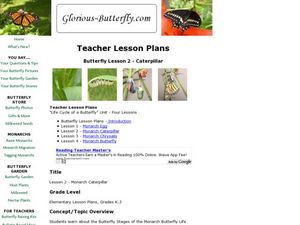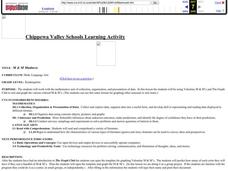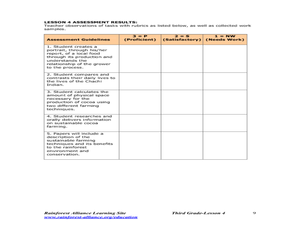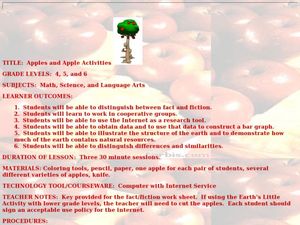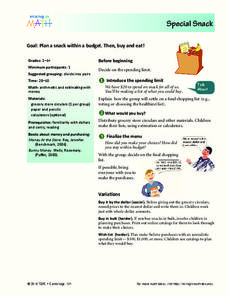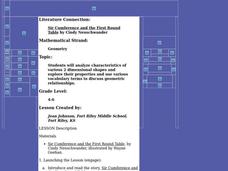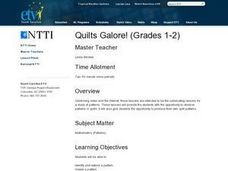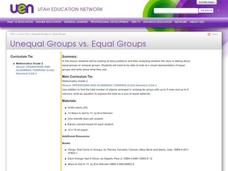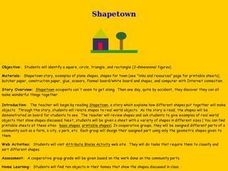Curated OER
Butterfly Lesson 2 - Monarch Caterpillar
Learners study the Monarch Butterfly life cycle. In this Monarch Butterfly instructional activity, students examine what happens prior to a caterpillar hatching, how often it sheds its skin, and what the caterpillar goes through when it...
Curated OER
Junk Sort
Students analyze objects by one or more attributes. In this sorting lesson, students use manipulatives and string or yarn to create a sorting game. Students read books and items from the classroom to sort.
Curated OER
Teddy Bears Everywhere
Learners explore the history of teddy bears. In this comprehension lesson, students bring a bear of their own to compare and contrast with their classmates. Learners read book and discuss the events and draw pictures of the scenes.
Curated OER
The Big Buck Adventure
Learners practice making change, and adding and subtracting money. In this money lesson, students listen to a reading of The Big Buck Adventure by Shelley Gil. They access teacher assigned web sites to practice making change, adding...
Curated OER
Graphing the Weather
Fourth graders predict the weather for their area using simple weather instruments. They take readings for a month during a season and graph their results. Students describe weather patterns based on their data and predict future weather...
Curated OER
Math Word Problems
In this math word problems worksheet, learners read and problem solve by subtracting. In this fill in the blank worksheet, students solve three problems.
Curated OER
M & M Madness
Students work with the mathematics unit of collection, organization, and presentation of data. In this math and technology lesson plan, students use Valentine M & M’s and The Graph Club to sort and graph the various colored M & M’s.
Curated OER
Equadorian Rainforest: The Tropical Supermarket
Students study the concept of sustainable agricultural practices through cocoa farming and the lives of the people who are the producers. Students watch a slide show and read a story which helps them understand the origins of chocolate,...
Curated OER
Apples and Apple Activities
Students investigate apples. In this reading comprehension lesson, students read a book about apples then compare and contrast, make graphs, distinguish between fact and fiction and work in groups. Students work in groups to search the...
Curated OER
Flag fun
First graders develop an understanding of the importance of the flag. In this flag lesson, 1st graders research the history of the flag. Students understanding of how the flag fosters pride in Americans. Students research the first...
Curated OER
Subtraction Word Problems
In this subtraction problem solving activity, students read and solve four word problems. Each word problem involves regrouping to the thousands place. There is an area on the activity for students to show their work.
Curated OER
Special Snack
Students explore grocery store circulars to choose items for a snack. In this snack math lesson, students must plan a class snack for $20.00. Students create a list estimating costs. Students view lists and choose one for their class. ...
Curated OER
First Rhythmic Composition
Young scholars apply fractions to counting rhythm in music. In this algebra lesson, students interrelate the concept of math into music as they fill out a chart identifying the names and symbols of music notes and their equivalent values...
Curated OER
"Sir Cumference and the First Round Table" by Cindy Neuschwander
Students analyze characteristics of various 2 dimensional shapes and explore their properties and use various vocabulary terms to discuss geometric relationships.
Utah Education Network (UEN)
Picnic Field Day
Using laminated paper cookies, get your class exploring the concept of division. Read them One Hundred Hungry Ants, by Elino R.J. Princzes, and have learners model what is happening with toy plastic ants. There are many more fun...
Curated OER
Little Boy Blue
First graders read nursery rhymes and celebrate Mother Goose. In this drawing conclusions and predicting lesson, 1st graders create new ending for the nursery rhymes. Students gather data and make a graph showing their favorite rhyme.
Curated OER
Quilts Galore
Students explore patterns. They observe a video, "Math Monsters." Students determine the next item in a sequence. Students read books about patterns. They discuss patterns in quilts. Students visit a specified web site and design...
Curated OER
Unequal Groups vs. Equal Groups
Third graders read and discuss math story problems and analyze if the story is using equal groups or unequal groups. They listen to the book "12 Ways To Get to 11," and simulate the story using beads on a pipe cleaner. Students then...
Curated OER
What Does Average Look Like?
Fifth graders explore the concepts of range, median, mode, and mean through the use of graphs drawn from models. They use manipulatives to represent data they have collected within their groups, and compare the differences between mode,...
Curated OER
Probability in Daily Life
Sixth graders examine the use of probability in daily life. In this probability lesson, 6th graders listen to scenarios from Louis Sachar's, Holes, after discussing probability in everyday life. They pretend they are detectives who are...
Curated OER
Shapetown
Learners identify basic geometric shapes. In this geometry lesson, students read the book Shapetown and identify the various shapes from the story. Learners are given a sheet and draw part of a town using only shapes.
Curated OER
Explore the Ocean
Learners explore the oceans from their origin. In this oceans activity, students read and discuss excerpts from the Book of Genesis regarding the creation of the ocean. Learners then clean up a mock oil spill, measure the volume and area...
Curated OER
March of the Dividing Ant
Young scholars inspect divisibility rules. In this divisibility rules lesson, students study the relationship between factorization and the divisibility rules for 2, 3, 5, 6, 9, and 10. Young scholars read One Hundred Hungry Ants and A...
Curated OER
Table Settings
Students make organized lists and find patterns to help them solve problems. They draw table formations and label how many people can sit there. They make predictions about how the tables be set up and what happen to the seating.


